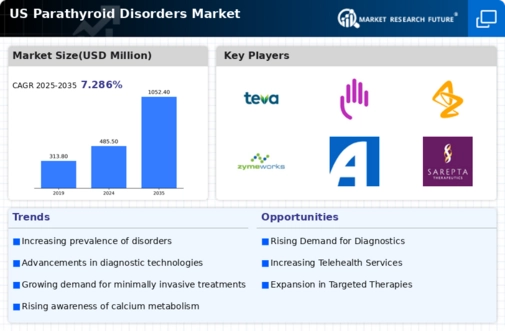Advancements in Surgical Techniques
Innovations in surgical techniques for treating parathyroid disorders are significantly impacting the parathyroid disorders market. Minimally invasive procedures, such as video-assisted parathyroidectomy, have gained traction due to their reduced recovery times and lower complication rates. The American Association of Endocrine Surgeons reports that these techniques can lead to shorter hospital stays and quicker patient recovery, which is appealing to both patients and healthcare providers. As surgical methods continue to evolve, the demand for specialized surgical instruments and training will likely rise, contributing to the overall growth of the parathyroid disorders market.
Growing Demand for Diagnostic Testing
The demand for accurate and timely diagnostic testing for parathyroid disorders is on the rise, significantly influencing the parathyroid disorders market. As awareness of these conditions increases, healthcare providers are prioritizing early detection and intervention. The market for diagnostic tests, including serum calcium and parathyroid hormone assays, is projected to grow as more patients seek evaluation for symptoms related to parathyroid dysfunction. According to market analysis, the diagnostic segment is expected to account for a substantial share of the parathyroid disorders market, driven by advancements in testing technologies and increased healthcare expenditure.
Rising Incidence of Parathyroid Disorders
The increasing prevalence of parathyroid disorders in the US is a notable driver for the parathyroid disorders market. Conditions such as primary hyperparathyroidism and secondary hyperparathyroidism are becoming more common, particularly among older adults. According to the National Institutes of Health, the incidence of primary hyperparathyroidism is estimated to be around 1-4 cases per 1,000 individuals, with a higher occurrence in women. This rising incidence necessitates enhanced diagnostic and therapeutic options, thereby propelling the parathyroid disorders market forward. As healthcare providers seek to address this growing patient population, investments in research and development are likely to increase, further stimulating market growth.
Aging Population and Associated Health Issues
The aging population in the US is a critical driver for the parathyroid disorders market. As individuals age, the risk of developing parathyroid disorders, particularly primary hyperparathyroidism, increases. The US Census Bureau projects that by 2030, nearly 20% of the population will be 65 years or older, leading to a higher prevalence of age-related health issues. This demographic shift is likely to result in increased healthcare utilization, including diagnostic and therapeutic services for parathyroid disorders. Consequently, healthcare systems may need to adapt to accommodate the growing needs of this population, further propelling the parathyroid disorders market.
Increased Investment in Research and Development
The parathyroid disorders market is experiencing a surge in investment directed towards research and development. Pharmaceutical companies and biotech firms are focusing on developing novel therapies and diagnostic tools for parathyroid disorders. The National Institutes of Health has allocated substantial funding for research aimed at understanding the underlying mechanisms of these disorders, which could lead to innovative treatment options. This influx of investment is expected to enhance the availability of effective therapies, thereby expanding the parathyroid disorders market. Furthermore, collaborations between academic institutions and industry players may foster breakthroughs that could reshape treatment paradigms.






















Leave a Comment